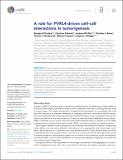| dc.contributor.author | Pallasch, Christian | |
| dc.contributor.author | Braun, Christian Joerg | |
| dc.contributor.author | Hemann, Michael | |
| dc.contributor.author | Pavlova, Natalya N. | |
| dc.contributor.author | Elia, Andrew E. H. | |
| dc.contributor.author | Westbrook, Thomas F. | |
| dc.contributor.author | Elledge, Stephen J. | |
| dc.date.accessioned | 2014-01-24T19:59:31Z | |
| dc.date.available | 2014-01-24T19:59:31Z | |
| dc.date.issued | 2013-04 | |
| dc.date.submitted | 2012-10 | |
| dc.identifier.issn | 2050-084X | |
| dc.identifier.uri | http://hdl.handle.net/1721.1/84514 | |
| dc.description.abstract | During all stages of tumor progression, cancer cells are subjected to inappropriate extracellular matrix environments and must undergo adaptive changes in order to evade growth constraints associated with the loss of matrix attachment. A gain of function screen for genes that enable proliferation independently of matrix anchorage identified a cell adhesion molecule PVRL4 (poliovirus-receptor-like 4), also known as Nectin-4. PVRL4 promotes anchorage-independence by driving cell-to-cell attachment and matrix-independent integrin β4/SHP-2/c-Src activation. Solid tumors frequently have copy number gains of the PVRL4 locus and some have focal amplifications. We demonstrate that the transformation of breast cancer cells is dependent on PVRL4. Furthermore, growth of orthotopically implanted tumors in vivo is inhibited by blocking PVRL4-driven cell-to-cell attachment with monoclonal antibodies, demonstrating a novel strategy for targeted therapy of cancer. | en_US |
| dc.language.iso | en_US | |
| dc.publisher | eLife Sciences Publications, Ltd. | en_US |
| dc.relation.isversionof | http://dx.doi.org/10.7554/eLife.00358 | en_US |
| dc.rights | Creative Commons Attribution | en_US |
| dc.rights.uri | http://creativecommons.org/licenses/by/3.0/ | en_US |
| dc.source | PMC | en_US |
| dc.title | A role for PVRL4-driven cell-cell interactions in tumorigenesis | en_US |
| dc.type | Article | en_US |
| dc.identifier.citation | Pavlova, N. N., C. Pallasch, A. E. Elia, C. J. Braun, T. F. Westbrook, M. Hemann, and S. J. Elledge. “A role for PVRL4-driven cell-cell interactions in tumorigenesis.” eLife 2, no. 0 (January 8, 2013): e00358-e00358. | en_US |
| dc.contributor.department | Massachusetts Institute of Technology. Department of Biology | en_US |
| dc.contributor.department | Koch Institute for Integrative Cancer Research at MIT | en_US |
| dc.contributor.mitauthor | Pallasch, Christian | en_US |
| dc.contributor.mitauthor | Braun, Christian Joerg | en_US |
| dc.contributor.mitauthor | Hemann, Michael | en_US |
| dc.relation.journal | eLife | en_US |
| dc.eprint.version | Final published version | en_US |
| dc.type.uri | http://purl.org/eprint/type/JournalArticle | en_US |
| eprint.status | http://purl.org/eprint/status/PeerReviewed | en_US |
| dspace.orderedauthors | Pavlova, N. N.; Pallasch, C.; Elia, A. E.; Braun, C. J.; Westbrook, T. F.; Hemann, M.; Elledge, S. J. | en_US |
| dc.identifier.orcid | https://orcid.org/0000-0002-5229-8748 | |
| mit.license | PUBLISHER_CC | en_US |
| mit.metadata.status | Complete | |
